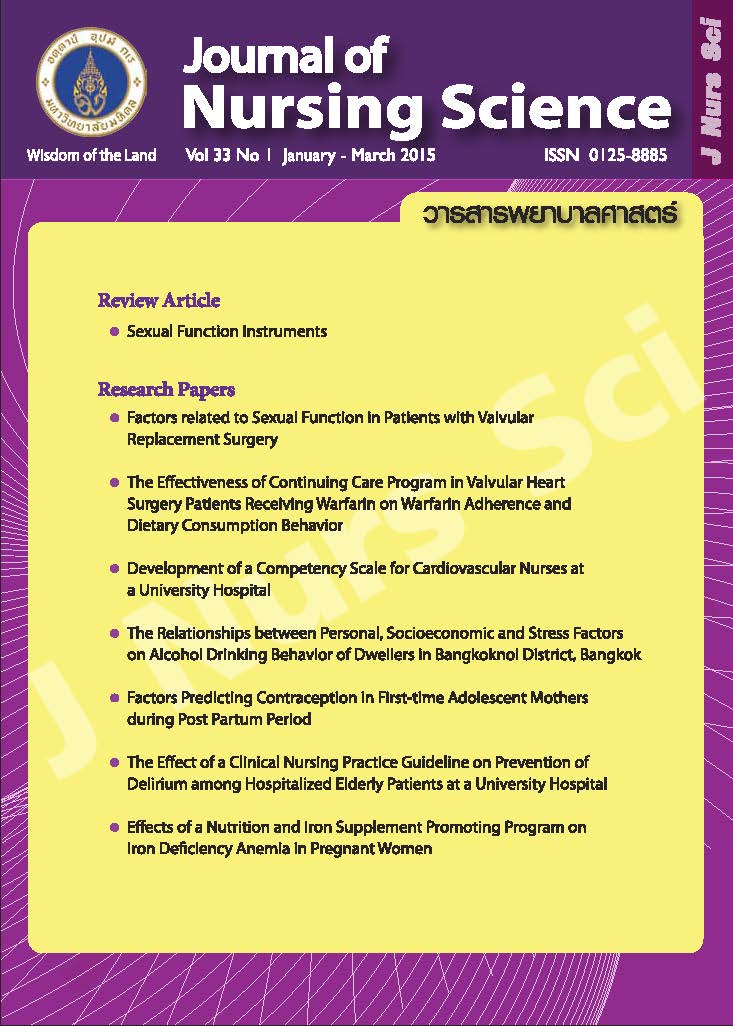Factors Predicting Contraception in First-time Adolescent Mothers during Post Partum Period
Main Article Content
Abstract
Purpose: The study was aimed to investigate the predictive power of factors including incomes, knowledge of contraception, attitudes toward contraception, and perceived support from significant persons to predict
contraception in first-time adolescent mothers in the postpartum period.
Design: A predictive study.
Method: The study participants consisted of 122 first-time postpartum adolescent mothers at a regional hospital, Ubon Ratchathani Province. Data were collected by using the demographic questionnaire, the knowledge of contraception questionnaire, the attitudes toward contraception questionnaire, the perceived support from significant person questionnaire, and the six-week postpartum interview questionnaire. Data were analyzed using the t-test, Mann-Whitney U test, and Logistic Regression Analysis.
Main findings: The study findings revealed that the factors of incomes, knowledge of contraception, attitudes toward contraception, and perceived support from significant persons could not predict contraception in first-time adolescent mothers during the postpartum period (p > .05). Moreover, it also found that adolescent mothers in this study had low levels of contraceptive knowledge (X = 6.72, SD = 3.04) and know only oral contraception pills (79.50%), most adolescent mothers (83.6%) accepted contraception when they came for 6 weeks postpartum check-ups, with the decision being made by their mothers.
Conclusion and recommendations: It is recommended that contraceptive knowledge should be provided to adolescents at 10 – 15 years old and again in pregnancy to postpartum period and all adolescent mothers should be encouraged to come for postpartum follow-ups. In addition, the mothers of adolescent mothers should be equipped with the correct knowledge of contraception to ensure effective and continued use of contraception in adolescent mothers.
ปัจจัยทำนายการคุมกำเนิดของมารดาวัยรุ่นที่มีบุตรคนแรกในระยะหลังคลอด
บทคัดย่อ
วัตถุประสงค์: เพื่อศึกษาความสามารถของปัจจัยด้านรายได้ ความรู้เกี่ยวกับการคุมกำเหนิด ทัศนคติต่อการคุมกำเนิด และการรับรู้การสนับสนุนจากบุคคลสำคัญ ในการทำนายการคุมกำเนิดของมารดาวัยรุ่นที่มีบุตรคนแรกในระยะหลังคลอด
รูปแบบการวิจัย: การวิจัยเชิงทำนาย
วิธีดำเนินการวิจัย: กลุ่มตัวอย่างเป็นมารดาวัยรุ่นหลังคลอดบุตรคนแรกที่พักรักษาตัวในโรงพยาบาล ประจำจังหวัดอุบลราชธานีจำนวน 122 ราย เก็บรวบรวมข้อมูลโดยใช้แบบสอบถามข้อมูลส่วนบุคคล แบบสอบถามความรู้เกี่ยวกับการคุมกำเนิด แบบสอบถามเกี่ยวกับทัศนคติต่อการคุมกำเนิด แบบสอบถามการรับรู้การสนับสนุนจากบุคคลสำคัญ และแบบสัมภาษณ์การคุมกำเนิด 6 สัปดาห์หลังคลอด วิเคราะห์ข้อมูลโดยใช้สถิติการทดสอบที (t - test) การทดสอบของแมนและ วิทนีย์ (Mann-Withney) และสถิติวิเคราะห์ถดถอยโลจิสติก (Logistic regression analysis)
ผลการวิจัย: ปัจจัยด้านรายได้ ความรู้เกี่ยวกับการคุมกำเหนิด ทัศนคติต่อการคุมกำเนิด และการรับรู้การสนับสนุนจากบุคคลสำคัญไม่สามารถทำนายการคุมกำเนิดของมารดาวัยรุ่นที่มีบุตรคนแรก ในระยะหลังคลอดได้ (p > .05) นอกจากนี้ยังพบว่า กลุ่มตัวอย่างมีความรู้ในการคุมกำเนิดน้อย (X = 8.35, SD = 3.04) และทราบเพียงการใช้ยาเม็ดคุมกำเนิดเท่านั้น (ร้อยละ 79.50) ส่วนใหญ่กลุ่มตัวอย่างมีการคุมกำเนิดเมื่อมาตรวจหลังคลอด 6 สัปดาห์ โดยมีมารดาเป็นผู้ตัดสินใจในการคุมกำเนิดของสตรีวัยรุ่น (ร้อยละ 83.6)
สรุปและข้อเสนอแนะ: ควรให้ความรู้เกี่ยวกับการคุมกำเนิด ตั้งแต่เริ่มเป็นวัยรุ่น ช่วงอายุ 10-15 ปี และให้อีกครั้งในทุกช่วงๆ ทั้งระยะตั้งครรภ์ คลอด ไปถึงหลังคลอด รวมไปถึงมารดาวัยรุ่นควรได้รับการส่งเสริมให้มาตรวจหลังคลอดทุกราย นอกจากนี้ มารดาของมารดาวัยรุ่นควรได้รับความรู้ที่ถูกต้องเกี่ยวกับการคุมกำเนิด เพื่อช่วยเหลือให้มารดาวัยรุ่นมีการคุมกำเนิดหลังคลอดอย่างมีประสิทธิภาพและต่อเนื่อง
คำสำคัญ: มารดาวัยรุ่น การคุมกำเนิดหลังคลอด ปัจจัยทำนาย
Article Details
Copyright Notice: Nursing Science Journal of Thailand has exclusive rights to publish and distribute the manuscript and all contents therein. Without the journal’s permission, the dissemination of the manuscript in another journal or online, and the reproduction of the manuscript for non-educational purpose are prohibited.

Disclaimer: The opinion expressed and figures provided in this journal, NSJT, are the sole responsibility of the authors. The editorial board bears no responsibility in this regard.


